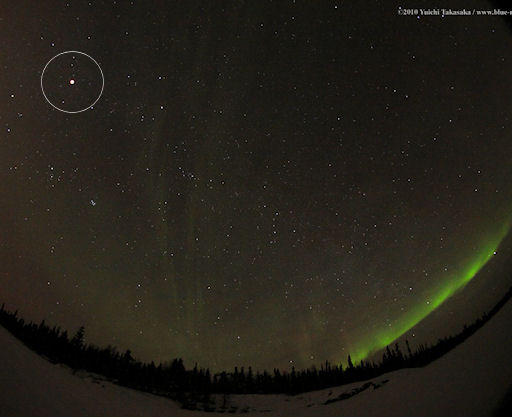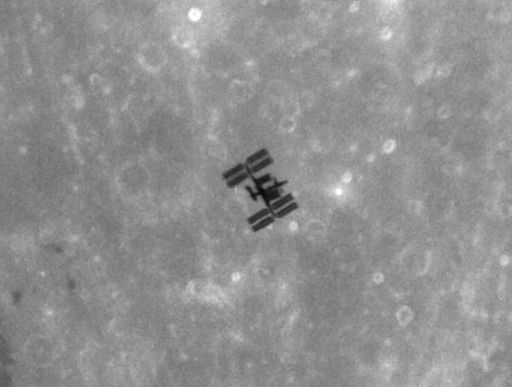These pictures are almost too hot to touch. Metallic photos of the sun make great Christmas gifts. | | | CHRISTMAS LIGHTS: On Christmas Eve, a bright light will glide through the night sky over North America--and we don't mean Santa's sleigh. It's the International Space Station putting on a spectacular holiday show. Check the Simple Satellite Tracker or your cell phone for flyby times. LUNAR ECLIPSE REVEALS AURORA BOREALIS: Normally, the full Moon is bad news for Northern Lights; lunar glare overwhelms the delicate aurora borealis. The full Moon of Dec. 21st, however, was different. It slipped into the shadow of Earth for a lunar eclipse, reducing the glare and revealing hidden auroras: 
Photo details: Canon EOS 5D MarkII and 500D. Sigma 8/3.5, EF 15/2.8, and EF 24/1.4L II lenses.
"Auroras were dancing in the northern sky throughout the eclipse," says photographer Yuichi Takasaka of Yellowknife in the Northwest Territories of Canada. In the snapshot, above, the Moon is circled, apparently not much brighter than surrounding stars. A video prepared by Takasaka shows how dramatically the sky darkened while the Moon was inside Earth's shadow. "What a night!" Lunar Eclipse Photo Gallery
[NASA: "Solstice Lunar Eclipse"] [astronomy alerts] BEFORE THE LUNAR ECLIPSE: Sometimes it pays get an early start; Dec. 21st was one of those times. Hours before Earth's shadow fell across the Moon, producing a solstice lunar eclipse witnessed by millions of people, astrophotographer Theirry Legault stood alone in Normandy, France, and watched a another shadow flit across the lunar surface first. It was the International Space Station: 
"I photographed the space station's silhouette using a Canon 5D Mark II at the prime focus of my Meade ACF 10-inch telescope," says Legault. Traveling around Earth at 17,000 mph, the ISS transited the lunar disk in a fraction of a second. "I captured the split-second event using a 1/2000s exposure." Legault, a veteran photographer of lunar and solar transits, uses Calsky to predict ground tracks and timing. Click here for a transit of your own.
November 2010 Aurora Gallery
[previous Novembers: 2009, 2008, 2007, 2006, 2004, 2003, 2002, 2001, 2000] Potentially Hazardous Asteroids ( PHAs) are space rocks larger than approximately 100m that can come closer to Earth than 0.05 AU. None of the known PHAs is on a collision course with our planet, although astronomers are finding new ones all the time. On December 24, 2010 there were 1167 potentially hazardous asteroids. Notes: LD means "Lunar Distance." 1 LD = 384,401 km, the distance between Earth and the Moon. 1 LD also equals 0.00256 AU. MAG is the visual magnitude of the asteroid on the date of closest approach. | | The official U.S. government space weather bureau | | | The first place to look for information about sundogs, pillars, rainbows and related phenomena. | | | Researchers call it a "Hubble for the sun." SDO is the most advanced solar observatory ever. | | | 3D views of the sun from NASA's Solar and Terrestrial Relations Observatory | | | Realtime and archival images of the Sun from SOHO. | | | from the NOAA Space Environment Center | | | the underlying science of space weather | | 
